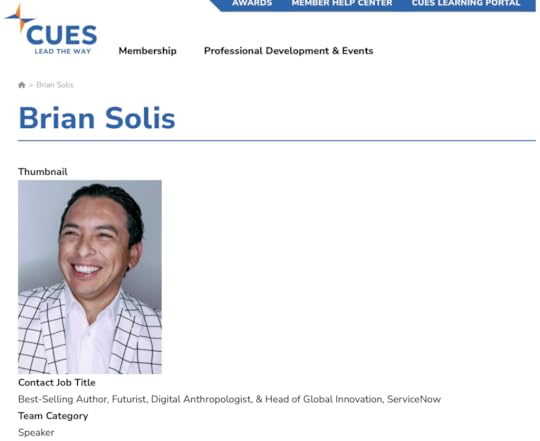Brian Solis's Blog, page 10
December 28, 2024
The Audience at CUES 2024 in Nashville Loved Brian’s Keynote
Brian Solis keynoted the CUES (Credit Union Executives Society) annual conference in Nashville. His keynote focused on AI-centered business transformation and how Credit Union leaders can reimagine member and employee experiences and services in an AI-First world.
“Brian was very engaging and the topic thought provoking. Members in the room wanted more!” – CUES
About CUESThe Credit Union Executives Society was founded in 1962 on the firmly held principle of “cooperation among cooperatives” not only for credit unions but also for CU managers. Since our start, we’ve grown into an organization dedicated to providing credit union professionals, directors and suppliers the resources they need to reach their greatest potential. Our passion is being the trusted, single source for our members’ professional development needs.
More than experiences, we create powerful relationships. From our small, yet mighty, staff to an expansive leadership network, we facilitate connections that provide invaluable support throughout our members’ leadership journey. Check out our annual report.
Our VisionCUES empowers Credit Union and system leaders of today and tomorrow to realize their potential, transforming their organizations, their communities, and the world.
CUES ValuesCooperative SpiritEmbracing collaboration and shared success, we embody a cooperative spirit that unites us with members and partners.
Member CentricWith an unwavering dedication to our members, we are committed to understanding them, serving them, and exceeding their expectations.
InnovationWe continuously improve and pioneer innovative solutions, so members and partners stay ahead of the curve in an ever-evolving industry landscape.
Solid StewardshipWe diligently manage resources and uphold the highest standards of integrity, ensuring our long-term success and the trust of our members and stakeholders.
The post The Audience at CUES 2024 in Nashville Loved Brian’s Keynote appeared first on Brian Solis.
December 27, 2024
From Art to Innovation: The Hidden Connection Between Picasso, Steve Jobs, and Apple

In December 1945 — January 1946, Picasso created “Le Taureau” or “The Bull”, a series of 11 stone prints that painstakingly explored the purest essence of a bull.
With each successive print, a bull is simplified and abstracted. It is considered as an iconic representation of absolute simplicity.
In 2008, Steve Jobs set out to teach employees at Apple this philosophy.
“You have to deeply understand the essence of a product in order to be able to get rid of the parts that are not essential.” — Steve Jobs
This is a reminder that getting to the essence of what you do or what you create isn’t easy, but it is what will separate you from everyone else.
This is an example of a mindshift. It’s the moment when you open your mind to explore new possibilities and discover extraordinary experiences and outcomes.
Jobs’ connection to Picasso’s “Le Taureau” inspired a new design mindset: “eliminate the unnecessary to get to the essence.” This mindset became the cornerstone of Apple’s design and product development process.
This philosophy of stripping away the non-essential to reveal the core essence of a product can be seen across many iconic Apple products.
Here are just a few examples:
iMac G3 (1998)The iMac G3 embodied simplicity with its single, bold, translucent shell. It removed legacy components like floppy drives, focusing on features essential for a modern computing experience.
iPod (2001)The iPod’s design, with its simple click-wheel interface and minimalist aesthetic, stripped away the complexity of MP3 players. It became a symbol of Jobs’ philosophy to “deeply understand the essence of a product.”
iPhone (2007)The original iPhone eliminated physical keyboards and buttons common in smartphones of the era. Its focus on a single, intuitive touchscreen interface represents the essence of Jobs’ idea of simplicity and anticipation of what users would want before they knew it.
iPad (2010)The iPad exemplified simplicity by offering a streamlined interface for browsing, reading, and media consumption. Its minimalist design was free from superfluous features.
Apple Watch (2015)The Apple Watch reduced the complexity of wearable technology, focusing on a sleek design and essential functionality while integrating it seamlessly into daily life.
macOS and iOS User InterfacesApple’s software interfaces reflect a commitment to clarity and usability, removing unnecessary complexity to create seamless experiences.
The Work of ArtJobs once said, “Our job is to figure out what they’re going to want before they do.”
Mastering the art of simplicity is to master the essence of innovation, to see something others miss, and to deliver it in a way that transforms perspectives and standards. Simplicity isn’t easy—but this mindshift is what separates the ordinary from the extraordinary.
If I can leave you with one final bit of advice, edit. Edit until you arrive at the essence, the art of your work, to make it meaningful and special for someone else. This is the advice Jobs shared with then Nike president and CEO Mark Parker.
Please consider reading, Mindshift: Transform Leadership, Drive Innovation, and Reshape the Future
Please subscribe to AInsights, here.
If you’d like to join my master mailing list for news and events, please sign-up at a Quantum of Solis.
The post From Art to Innovation: The Hidden Connection Between Picasso, Steve Jobs, and Apple appeared first on Brian Solis.
December 15, 2024
The Inaugural ImpaQ Forum Debuts in Saudi Arabia, Features World’s Top Influencers and Creators

The Saudi Ministry of Media announced on Thursday the launch of the ImpaQ Impact Makers Forum, set to take place on Dec. 18-19 in Riyadh.
The landmark event, announced by media minister Salman bin Yousef Al-Dosari, will be Saudi Arabia’s largest gathering for influencers, digital content creators and industry experts, aimed at redefining the role of influence in the rapidly evolving digital landscape.
The forum is expected to bring together more than 300 influencers from around the world, spanning diverse fields and specializations, including Brian Solis
Designed to foster meaningful dialogue between local and international talent, the forum will explore ways to enrich societal values, promote purpose-driven influence and share expertise.
“A big part of me is geeking out as I get to see OG influencers and friends all in one place, meet some of the biggest names in the game, and learn how to help my company, colleagues, and customers thrive in an AI first world,” said Solis.
Creators and influencers include:
ALLI WEBB
AMY LANDINO
ANDREW ZIMMERN
CARLI LLOYD
DREW BINSKY
LARRY MILLER
LUKE KORNS
MANUEL ARNAUT
MARK POLLARD
MATTHEW HIGGINS
MR INDIAN HACKER
MURAD HAUSSMAN
NIKOLAI SAVIC
LUCIEN LAVISCOUNT
PHILIP KOTLER
RACHEL DEMITA
RAYA ABI RASHED
SCHOOL OF HARDKNOCKS
SCOTT GALLOWAY
SENGIN ALIOGLU
STEVEN BARLETT
The post The Inaugural ImpaQ Forum Debuts in Saudi Arabia, Features World’s Top Influencers and Creators appeared first on Brian Solis.
November 25, 2024
What is a Mindshift and Why Now? Plus Updates, Offers, and a Personal Request

Before we jump in, I have some updates, offers, and a personal request.
Let me start by wishing you and your loved ones a very Happy Holidays! 

I recently returned from a wonderful trip to Vienna, where I participated in the Global Drucker Forum. I still need to take some time to write about my experience there—it truly inspired me to think like I did in the early days!
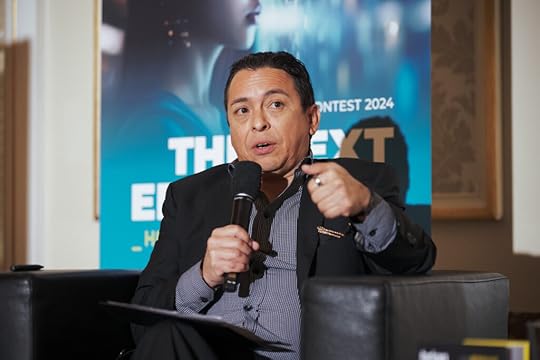
A heartfelt thank you to Stephan Balzer for hosting an incredible conversation about Mindshift and generative AI disruption. Additional thanks to Richard Straub and Julia Kirby for their invitation and unwavering support throughout my Drucker Forum journey. I hope it’s the first of many!
I have to say, Vienna during the holidays is an unforgettable experience. 



From there, I spent time in New York before continuing to Chicago, where our ServiceNow team organized an impressive presence at Microsoft Ignite. In my role, I had the privilege of hosting a special executive lunch featuring Netflix Co-Founder Marc Randolph, where we spent an hour exploring how to navigate AI disruption. I will definitely write about this experience!
Personalizing BooksNow that I’m back home, I’ve been spending the weekend personalizing copies of my new book, Mindshift , for friends and colleagues. I’m definitely exercising muscles I forgot I had!


 If you’d like a personalized copy—or if you’d like to send copies to your teams or customers (or have me do it for you)—please let me know! I’ve mastered shipping envelopes, boxes, and even learned how to use Media Mail at USPS.
If you’d like a personalized copy—or if you’d like to send copies to your teams or customers (or have me do it for you)—please let me know! I’ve mastered shipping envelopes, boxes, and even learned how to use Media Mail at USPS.  Just send an email, and I’ll reply with all the details.
Just send an email, and I’ll reply with all the details.If you need bulk copies (10 or more, up to the hundreds), I’m also offering some exclusive deals!
Favor: Book Reviews
If you’ve read Mindshift, I have a personal request: could you take a moment to leave a review on Amazon or Goodreads? Reviews provide valuable insights for potential readers and fuel the algorithms that help books show up in related searches.
As a thank you, if you write a review, please send your mailing address via email—I’ll send you a custom Mindshiftbookmark, hot off the press! 

 Between signing, packing, and shipping books, I’ve been catching up on writing answers for upcoming articles about
Mindshift
. Surprisingly, I’m not often asked the question: What is a mindshift, and why now?
Between signing, packing, and shipping books, I’ve been catching up on writing answers for upcoming articles about
Mindshift
. Surprisingly, I’m not often asked the question: What is a mindshift, and why now?Here’s how I explained it to one media outlet, and I thought I’d share it with you:
A mindshift was born from the phrase, “What we need is a mindset shift,” which I said repeatedly before finally dropping “set” and combining what was left.
While technology is advancing exponentially, our mindsets, approaches, and leadership frameworks are struggling to keep pace. To thrive, leaders must ignite a new form of awareness and creativity—one that transcends traditional business principles and embraces deeper exploration of the unknown, along with a profound understanding of humanity and its evolving needs.
A mindshift represents a profound change in how we perceive the world, approach challenges, and embrace opportunities. It’s not just about adopting new ideas—it’s about rewiring our perspectives, unlearning outdated beliefs, and embracing the future with curiosity and wonder. It’s the key to moving from survival mode to thriving in a future defined by the unknown, uncertainty, and disruption.
A mindshift often occurs when individuals or leaders realize the status quo is no longer sufficient. They recognize that clinging to old mindsets or strategies limits progress. This realization can be triggered by disruptive events such as technological breakthroughs, market shifts, global crises, or personal epiphanies. In these moments, a choice arises: resist change and remain reactive, or embrace a new way of thinking to proactively shape the future.
A mindshift isn’t just about reacting to disruption—it’s about anticipating it, harnessing it, and seeing around corners. It’s a decision to break free from legacy thinking, embrace curiosity, and open the door to new possibilities. Ultimately, a mindshift enables leaders to navigate ambiguity, inspire teams, and drive innovation in a rapidly changing world.
Think of the mindshift moment as a “Ctrl + Alt + Delete” opportunity—a chance to reboot your mindset and take intentional steps toward reinvention. It’s an intellectual and creative upgrade, a gift we can give ourselves and those we care about.
So, let’s go! Let’s embrace a mindshift and share this gift with the world. 
Thank you for reading, and wishing you a joyful and transformative holiday season! 

– Brian
—
My first book in five years is finally out! It’s called Mindshift: Transform Leadership, Drive Innovation, and Reshape the Future. Please visit Mindshift.ing to get your copy and join the movement to help design a better future!
Please subscribe to AInsights, here.
If you’d like to join my master mailing list for news and events, please sign-up at a Quantum of Solis.
The post What is a Mindshift and Why Now? Plus Updates, Offers, and a Personal Request appeared first on Brian Solis.
November 14, 2024
AInsights: From Conversation to Creation, How ChatGPT 4o’s Canvas Transforms AI Collaboration
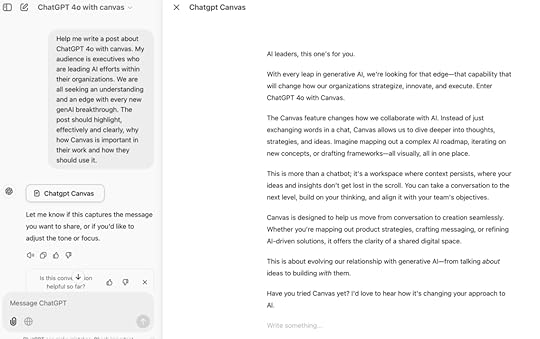
AInsights: Your executive-level insights making sense of the latest in generative AI…
My new book, Mindshift: Transform Leadership, Drive Innovation, and Reshape the Future, just launched. I’m catching up on the biggest news coming out of the genAI world.
Here’s more from OpenAI.
The company recently announced its competitor to Google Search and in some respect, Perplexity, but so far, only in specific applications such as writing and coding. Canvas, provides a new window into collaborating with generative AI.
On the heels of Google’s NotebookLM and building on integrated ‘Co-Pilots’ we see in popular software suites across the board, OpenAI’s Canvas offers the ability to collaborate with AI in the creation of written works and code.
If you’ve used Perplexity Pages, you’ll find that the key difference is that Canvas is more of a collaboration tool in the creation process. Perplexity Pages offers users the ability to create, edit, and publish content derived from Perplexity search and research projects. I use both.
Explaining CanvasCanvas features a dual-panel window that features a side-by-side layout where users can engage in regular chat while simultaneously working on projects in a dedicated workspace.
The left side is where you partner with ChatGPT. The right side reflects your work, in this case, writing for code.
On the collaboration side, you’ll find a simple interface to chat, upload materials, and collaborate with the AI, which is then reflected in the right panel.
The writing and coding side of the interface offers creating and editing tools similar to those found in Microsoft Co-Pilot, Medium, and Substack. Highlighting specific sections of work here, guides ChatGPT where to help you, make improvements, or offer suggestions.
Additional Details:
Uploading additional files can allow ChatGPT to customize your work or collaborate with you specific to the task at hand.
The interface allows you to edit text or code directly and offers various shortcuts for tasks such as adjusting writing length or debugging code.
You can restore previous versions of their work, which is particularly useful during iterative processes.
Also Canvas can serve as an editor or coach guiding users where areas can be improved, offering suggestions in how to do so.
Essentially, Canvas is an intelligent collaboration partner, collaborative workspace, and a real-time doc and code editor.
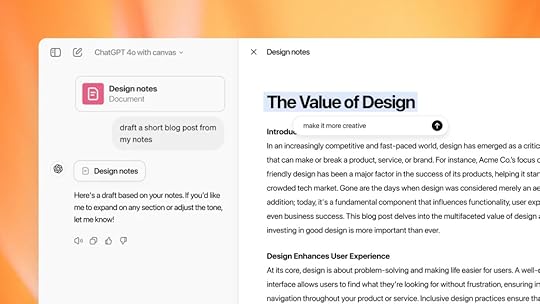
Using Canvas, I asked it to tell me more about what it is and how it helps executives. The prompt is the image used for this post! Here’s what was shared…
The Canvas feature changes how we collaborate with AI. Instead of just exchanging words in a chat, Canvas allows us to dive deeper into thoughts, strategies, and ideas. Imagine mapping out a complex AI roadmap, iterating on new concepts, or drafting frameworks—all visually, all in one place.
This is more than a chatbot; it’s a workspace where context persists, where your ideas and insights don’t get lost in the scroll. You can take a conversation to the next level, build on your thinking, and align it with your team’s objectives.
Canvas is designed to help us move from conversation to creation seamlessly. Whether you’re mapping out product strategies, crafting messaging, or refining AI-driven solutions, it offers the clarity of a shared digital space.
This is about evolving our relationship with generative AI—from talking about ideas to building with them.
The response is helpful. As you can see in the post images at the top, the split window is where Canvas changes the usual ChatGPT experience. So now, with a dual interface, you can upload materials, further prompt the interface, and shape the content into a publishable or shareable format. Shift to the right panel and now you can edit, inline, the text to also be publishable or shareable. Highlight text and you can further collaborate with ChatGPT around specific areas to adjust tone, length, or enhance the content to specific outcomes.
AInsightsOpenAI Canvas represents a creative advancement in how business users can leverage AI for productivity. Its dual-window interface promotes deeper collaboration between users and AI, making it a new type of tool for executives to enhance their workflows, how they create, methods for research and analytics, and more.
Here are a handful of potential use cases for executives in their everyday work:
1. Enhanced Content Creation
Marketing Materials: Executives can utilize Canvas to draft and refine marketing content, ensuring that messaging aligns with brand voice and strategy.
Technical Documentation: The tool aids in creating clear and concise technical documents by allowing users to collaborate closely with AI on complex subjects.
2. Improved Coding Efficiency
Code Development: Developers can leverage Canvas for coding projects, receiving inline feedback and suggestions from ChatGPT while maintaining the overall context of the codebase.
Debugging Support: The ability to highlight code sections and request specific debugging assistance helps streamline the development process.
3. Collaborative Team Projects
Real-Time Collaboration: Teams can work together in real time, using Canvas as a platform for brainstorming sessions or project planning, facilitating better communication and idea sharing.
Iterative Refinement: Executives can treat Canvas as a collaborative partner, iterating on drafts or code until the desired outcome is achieved, rather than expecting perfection on the first attempt1.
4. Training and Development
Skill Enhancement: By using Canvas, employees can improve their writing and coding skills through direct interaction with AI, receiving immediate feedback that fosters learning and development.
5. Data-Driven Decision Making
Report Generation: Executives can generate reports by collating data inputs through Canvas, enhancing the efficiency of data analysis tasks.
Presentation Preparation: The tool can assist in drafting presentations by organizing thoughts and providing structured content suggestions.
For the time being, I’m going to use Canvas as my authoring tool for this newsletter. Let’s see how it goes!
—
My first book in five years is finally out! It’s called Mindshift: Transform Leadership, Drive Innovation, and Reshape the Future. Please visit Mindshift.ing to learn more!
Please subscribe to AInsights, here.
If you’d like to join my master mailing list for news and events, please follow, a Quantum of Solis.

The post AInsights: From Conversation to Creation, How ChatGPT 4o’s Canvas Transforms AI Collaboration appeared first on Brian Solis.
November 12, 2024
AInsights: OpenAI Introduces SearchGPT; Disrupts Google Again
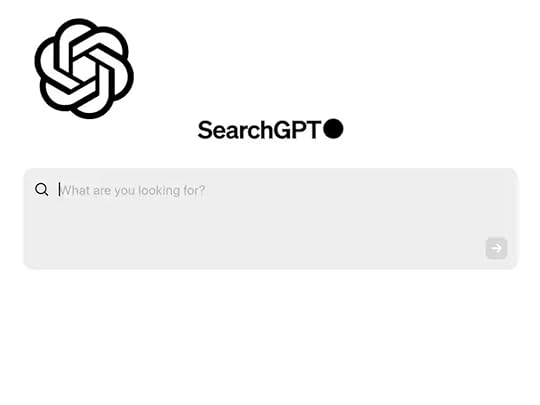
AInsights: Your executive-level insights making sense of the latest in generative AI…
With the launch of my new book, Mindshift: Transform Leadership, Drive Innovation, and Reshape the Future, I’m a little behind in covering some of the industry’s biggest genAI news!
So, let’s jump right in…
During the summer of 2024, OpenAI previewed a prototype of AI search, designed to offer fast and timely answers with “clear and relevant sources.” It was marketed as a new way to search.
On Halloween 2024, OpenAI officially debuted ChatGPT Search, officially taking on traditional search engines and also Perplexity AI at the same time.
The crux of ChatGPT Search is that it blends a natural language, conversational, interface with real-time info curated by generative AI and provides links to relevant web sources in the results.
ChatGPT Search provides allows users to interact with information in a more natural way. What’s important here is that users, I don’t love that term, can ask follow-up questions and the AI will consider the full context of the chat to provide better answers.
SearchGPT can automatically determine when to search the web based on user queries, but users also have the option to manually trigger searches by clicking a small blue search button. It’s best-of-breed historical, intelligent search, combined with real-time web search functionality.
Instead of providing a list of links, I’m looking at you Google, ChatGPT Search synthesizes information to give direct answers to queries, while providing links to sources vs algorithmic results. This allows users to get concise, relevant answers without having to sift through multiple search results to apply a human filter to arrive at the most pertinent result. I can’t say that enough.
We, as users, have to sift through algorithmic results in a personal attempt to find the right results. It’s not always easy or effective, which means that we’ll turn to more trusted, peer-driven, results ons sites such as Instagram, TikTok, and Youtube
Here are some of the key features and differentiators of ChatGPT Search…
Conversational Interface
ChatGPT search combines search functionality with a conversational interface, offering a more intuitive way to interact with information. Users can ask follow-up questions, and ChatGPT will consider the full context of the chat to provide better answers.
Web Search Integration
ChatGPT can now search the web to provide up-to-date information on a wide range of topics. This allows users to get current information on everything from weather forecasts to stock prices, news, and more.
Source Attribution
ChatGPT search provides links to sources for the answers it gives, allowing users to verify information and explore topics more deeply. A “Sources” button below the response opens a sidebar with references for further interaction.
Partnerships with Publishers
OpenAI has collaborated with various news organizations and publishers to ensure reliable information sources. These partnerships include agreements with Associated Press, Axel Springer, Financial Times, Reuters, and several other publishers.
AInsightsThe biggest frustration with search or any social platform these days is that results and feeds are the product of whatever the latest algorithm is on any given platform. Or, results become the product of the best search engine marketers in the game.
On Google, especially, an entire industry and sub-industries exist to uplift results onto page one, or even better, page zero (the summary, now AI, on the top of the results page). But, it doesn’t mean, at least on Google search, that the results are the most accurate. Instead, the result is the most, usually, manufactured, and not aligned to a user’s desired outcome. Even
One of the biggest, unforeseen threats, to conventional search is the conversational aspect of generative AI prompts. Those, for years, users have typed more conversational queries into search boxes, results were algorithmically optimized (or gamed) to align with the search query. We usually referred to it as keyword anthropology.
But unlike Google’s scrolling list of links, ChatGPT provides synthesized, direct answers to queries, potentially streamlining the search process. The goal is to combine web search with ChatGPT’s language understanding to provide more contextually relevant results.
I’ve always believed, context is king. Relevant, intuitive, meaningful content is inspired by context.
You may or may not know, but I’m a huge fan, and customer, of Perplexity. I use Perplexity as a research and deep search engine. I appreciate the sources and citations, which allow me to further understand any given subject by reading and learning at my own direction.
SearchGPT appears to be following this path and I look forward to comparing the results. I’m also a paying customer of ChatGPT, so this is will all be to my benefit! 
With that said, OpenAI is taking on Google and Perplexity with SearchGPT.
Let’s breakdown the differences between them for executive users:
Google ranks web pages based on authority, relevance, and SEO factors, providing lists of links to various sources.
Perplexity provides synthesized answers derived from multiple reputable sources, emphasizing clarity and factual accuracy. It allows follow-up questions in a conversational format.
SearchGPT delivers conversational AI-driven answers directly within search results. It adapts responses based on user context and queries.
One use case might be to explore SearchGPT’s ability to help with running competitive analyses…
Business executives can leverage SearchGPT’s real-time data capabilities for competitive analysis in several impactful ways. The integration of real-time search functionality allows for immediate insights into market trends, competitor activities, and consumer behavior, which are essential for strategic decision-making. Key Strategies for Leveraging SearchGPT
1. Real-Time Market Insights: SearchGPT enables businesses to gather immediate insights into market trends and shifts. Executives can monitor emerging trends and competitor strategies as they happen, allowing for timely adjustments to their business strategies. This capability is crucial in fast-paced industries where staying ahead of the curve can significantly impact market positioning.
2. Competitive Analysis and Benchmarking: Utilizing SearchGPT, businesses can conduct thorough competitive analyses by tracking competitor activities and evaluating industry benchmarks. By comparing their performance metrics against industry standards in real time, companies can identify areas of strength and weakness, inspiring innovation and continuous improvement. This information helps executives set achievable targets and adjust strategies proactively.
3. Data-Driven Audience Insights: SearchGPT can provide detailed insights into specific audience segments by analyzing real-time data related to customer preferences and behaviors. This enables businesses to refine their marketing messages and campaign strategies based on current consumer trends, enhancing personalization efforts and aligning more closely with customer needs.
4. Responsive Customer SupportL The platform facilitates efficient customer interactions by providing instant access to relevant information. Executives can use SearchGPT to enhance customer support systems, enabling teams to respond quickly to inquiries with accurate, up-to-date information. This responsiveness not only improves customer satisfaction but also strengthens brand loyalty.
5. Agile Decision-Making: Real-time data analysis through SearchGPT empowers executives to make informed decisions rapidly. By analyzing current market conditions, operational metrics, and consumer feedback as they occur, businesses can adapt strategies swiftly to changing circumstances, thereby maintaining a competitive edge.
6. Identifying Opportunities for Innovation: By continuously monitoring the competitive landscape using SearchGPT, executives can spot gaps in the market or areas where competitors excel. This insight can drive innovation within their own organizations, leading to the development of new products or services that meet emerging consumer demands.
—
My first book in five years is out! It’s called Mindshift: Transform Leadership, Drive Innovation, and Reshape the Future. And, it’s available to order now. Please visit Mindshift.ing to learn more!
Please subscribe to AInsights, here.
If you’d like to join my master mailing list for news and events, please follow, a Quantum of Solis.

The post AInsights: OpenAI Introduces SearchGPT; Disrupts Google Again appeared first on Brian Solis.
AInsights: OpenAI Introducing SearchGPT; Disrupts Google Again

AInsights: Your executive-level insights making sense of the latest in generative AI…
With the launch of my new book, Mindshift: Transform Leadership, Drive Innovation, and Reshape the Future, I’m a little behind in covering some of the industry’s biggest genAI news!
So, let’s jump right in…
During the summer of 2024, OpenAI previewed a prototype of AI search, designed to offer fast and timely answers with “clear and relevant sources.” It was marketed as a new way to search.
On Halloween 2024, OpenAI officially debuted ChatGPT Search, officially taking on traditional search engines and also Perplexity AI at the same time.
The crux of ChatGPT Search is that it blends a natural language, conversational, interface with real-time info curated by generative AI and provides links to relevant web sources in the results.
ChatGPT Search provides allows users to interact with information in a more natural way. What’s important here is that users, I don’t love that term, can ask follow-up questions and the AI will consider the full context of the chat to provide better answers.
SearchGPT can automatically determine when to search the web based on user queries, but users also have the option to manually trigger searches by clicking a small blue search button. It’s best-of-breed historical, intelligent search, combined with real-time web search functionality.
Instead of providing a list of links, I’m looking at you Google, ChatGPT Search synthesizes information to give direct answers to queries, while providing links to sources vs algorithmic results. This allows users to get concise, relevant answers without having to sift through multiple search results to apply a human filter to arrive at the most pertinent result. I can’t say that enough.
We, as users, have to sift through algorithmic results in a personal attempt to find the right results. It’s not always easy or effective, which means that we’ll turn to more trusted, peer-driven, results ons sites such as Instagram, TikTok, and Youtube
Here are some of the key features and differentiators of ChatGPT Search…
Conversational Interface
ChatGPT search combines search functionality with a conversational interface, offering a more intuitive way to interact with information. Users can ask follow-up questions, and ChatGPT will consider the full context of the chat to provide better answers.
Web Search Integration
ChatGPT can now search the web to provide up-to-date information on a wide range of topics. This allows users to get current information on everything from weather forecasts to stock prices, news, and more.
Source Attribution
ChatGPT search provides links to sources for the answers it gives, allowing users to verify information and explore topics more deeply. A “Sources” button below the response opens a sidebar with references for further interaction.
Partnerships with Publishers
OpenAI has collaborated with various news organizations and publishers to ensure reliable information sources. These partnerships include agreements with Associated Press, Axel Springer, Financial Times, Reuters, and several other publishers.
AInsightsThe biggest frustration with search or any social platform these days is that results and feeds are the product of whatever the latest algorithm is on any given platform. Or, results become the product of the best search engine marketers in the game.
On Google, especially, an entire industry and sub-industries exist to uplift results onto page one, or even better, page zero (the summary, now AI, on the top of the results page). But, it doesn’t mean, at least on Google search, that the results are the most accurate. Instead, the result is the most, usually, manufactured, and not aligned to a user’s desired outcome. Even
One of the biggest, unforeseen threats, to conventional search is the conversational aspect of generative AI prompts. Those, for years, users have typed more conversational queries into search boxes, results were algorithmically optimized (or gamed) to align with the search query. We usually referred to it as keyword anthropology.
But unlike Google’s scrolling list of links, ChatGPT provides synthesized, direct answers to queries, potentially streamlining the search process. The goal is to combine web search with ChatGPT’s language understanding to provide more contextually relevant results.
I’ve always believed, context is king. Relevant, intuitive, meaningful content is inspired by context.
You may or may not know, but I’m a huge fan, and customer, of Perplexity. I use Perplexity as a research and deep search engine. I appreciate the sources and citations, which allow me to further understand any given subject by reading and learning at my own direction.
SearchGPT appears to be following this path and I look forward to comparing the results. I’m also a paying customer of ChatGPT, so this is will all be to my benefit! 
With that said, OpenAI is taking on Google and Perplexity with SearchGPT.
Let’s breakdown the differences between them for executive users:
Google ranks web pages based on authority, relevance, and SEO factors, providing lists of links to various sources.
Perplexity provides synthesized answers derived from multiple reputable sources, emphasizing clarity and factual accuracy. It allows follow-up questions in a conversational format.
SearchGPT delivers conversational AI-driven answers directly within search results. It adapts responses based on user context and queries.
One use case might be to explore SearchGPT’s ability to help with running competitive analyses…
Business executives can leverage SearchGPT’s real-time data capabilities for competitive analysis in several impactful ways. The integration of real-time search functionality allows for immediate insights into market trends, competitor activities, and consumer behavior, which are essential for strategic decision-making. Key Strategies for Leveraging SearchGPT
1. Real-Time Market Insights: SearchGPT enables businesses to gather immediate insights into market trends and shifts. Executives can monitor emerging trends and competitor strategies as they happen, allowing for timely adjustments to their business strategies. This capability is crucial in fast-paced industries where staying ahead of the curve can significantly impact market positioning.
2. Competitive Analysis and Benchmarking: Utilizing SearchGPT, businesses can conduct thorough competitive analyses by tracking competitor activities and evaluating industry benchmarks. By comparing their performance metrics against industry standards in real time, companies can identify areas of strength and weakness, inspiring innovation and continuous improvement. This information helps executives set achievable targets and adjust strategies proactively.
3. Data-Driven Audience Insights: SearchGPT can provide detailed insights into specific audience segments by analyzing real-time data related to customer preferences and behaviors. This enables businesses to refine their marketing messages and campaign strategies based on current consumer trends, enhancing personalization efforts and aligning more closely with customer needs.
4. Responsive Customer SupportL The platform facilitates efficient customer interactions by providing instant access to relevant information. Executives can use SearchGPT to enhance customer support systems, enabling teams to respond quickly to inquiries with accurate, up-to-date information. This responsiveness not only improves customer satisfaction but also strengthens brand loyalty.
5. Agile Decision-Making: Real-time data analysis through SearchGPT empowers executives to make informed decisions rapidly. By analyzing current market conditions, operational metrics, and consumer feedback as they occur, businesses can adapt strategies swiftly to changing circumstances, thereby maintaining a competitive edge.
6. Identifying Opportunities for Innovation: By continuously monitoring the competitive landscape using SearchGPT, executives can spot gaps in the market or areas where competitors excel. This insight can drive innovation within their own organizations, leading to the development of new products or services that meet emerging consumer demands.
—
My first book in five years is out! It’s called Mindshift: Transform Leadership, Drive Innovation, and Reshape the Future. And, it’s available to order now. Please visit Mindshift.ing to learn more!
Please subscribe to AInsights, here.
If you’d like to join my master mailing list for news and events, please follow, a Quantum of Solis.

The post AInsights: OpenAI Introducing SearchGPT; Disrupts Google Again appeared first on Brian Solis.
AInsights: Nvidia’s Bold Move: Open-Source AI That Challenges GPT-4 and Democratizes Innovation

AInsights: Your executive-level insights making sense of the latest in generative AI…
My new book, Mindshift: Transform Leadership, Drive Innovation, and Reshape the Future, just launched! Please join me on the journey to inspire a new genre of leadership and innovation!
Nvidia just dropped a bombshell: NVLM 1.0, an open-source family of large multimodal AI models designed to compete head-to-head—and even outperform—OpenAI’s GPT-4.
The highlight of this release is the NVLM-D-72B, a 72 billion parameter powerhouse that excels at both multimodal tasks (handling text and images) and text-only evaluations. The model has already proven itself in multiple benchmarks, even surpassing GPT-4 in certain mathematical tasks. And here’s the kicker: Nvidia has made it open and accessible, releasing model weights and planning to share the training code. This move democratizes advanced AI, putting cutting-edge technology directly into the hands of organizations, big and small, without the traditional financial and technical barriers.
This is a turning point for Nvidia. Known for its leadership in GPU technology, Nvidia is now flexing its muscles in the AI software space. This strategic shift positions the company to directly compete with established software leaders, reshaping the industry dynamics and pushing the boundaries of what’s possible in AI.
AInsightsNvidia’s bold move here is about much more than tech—it’s a paradigm shift in how businesses can access and implement AI. By making sophisticated AI more accessible, Nvidia is tearing down the walls that have kept many organizations from experimenting with and deploying state-of-the-art models. For executives, this is an opportunity to accelerate innovation, leverage AI-driven insights, and rethink how AI can integrate into core business processes.
Why This Matters to Business ExecutivesDemocratizing AI with Open-Source Access
Nvidia is leveling the playing field by releasing NVLM 1.0 as open-source. This means that advanced AI is no longer confined to tech giants with deep pockets. Businesses of all sizes can experiment, customize, and implement these models, unlocking opportunities to innovate without the prohibitive costs of proprietary systems. Imagine the possibilities when any company can build AI capabilities that were once out of reach.
Cost-Efficiency and Scalability
With Nvidia offering hosted inference on its platform, companies have a cost-effective pathway to integrate AI into their operations. This drastically reduces deployment expenses and lowers the barrier to entry for AI-driven solutions, enabling businesses to scale up their capabilities without the heavy investments often required by proprietary models from the likes of OpenAI.
Flexibility for Tailored Solutions
NVLM models aren’t just powerful—they’re adaptable. Whether it’s automating customer interactions, generating internal reports, or creating personalized content, these models can be customized to fit the unique needs of any business. This level of flexibility empowers companies to enhance productivity, streamline processes, and innovate in ways that are tightly aligned with their specific goals.
Shifting Competitive Dynamics
Nvidia’s move into the AI software arena challenges the status quo, putting pressure on established players like OpenAI and Google. This competition is likely to spur even faster advancements across the industry, as companies push to outdo each other. For executives, this means better tools, faster progress, and more opportunities to leverage AI for a competitive edge.
Accelerating Research and Collaboration
The open-source nature of NVLM 1.0 fosters an environment of collaboration. Researchers, startups, and smaller companies can contribute, iterate, and innovate together, pushing the boundaries of AI capabilities. For businesses, this means staying at the forefront of AI trends, tapping into the latest research, and benefiting from a rapidly evolving tech landscape.
Nvidia is not just playing catch-up in the AI software space—it’s leading a new wave of accessibility and innovation. For business leaders, this is a moment to pay attention. NVLM isn’t just another AI model; it’s a catalyst for change—an opportunity to rethink what’s possible, drive efficiency, lower costs, and, most importantly, foster a culture of innovation that will define the next era of business.
—
My first book in five years is finally out! It’s called Mindshift: Transform Leadership, Drive Innovation, and Reshape the Future. Please visit Mindshift.ing to learn more!
Please subscribe to AInsights, here.
If you’d like to join my master mailing list for news and events, please follow, a Quantum of Solis.

The post AInsights: Nvidia’s Bold Move: Open-Source AI That Challenges GPT-4 and Democratizes Innovation appeared first on Brian Solis.
November 2, 2024
Futurist Brian Solis to Keynote Integrated Systems Europe ISE 2025 in Barcelona
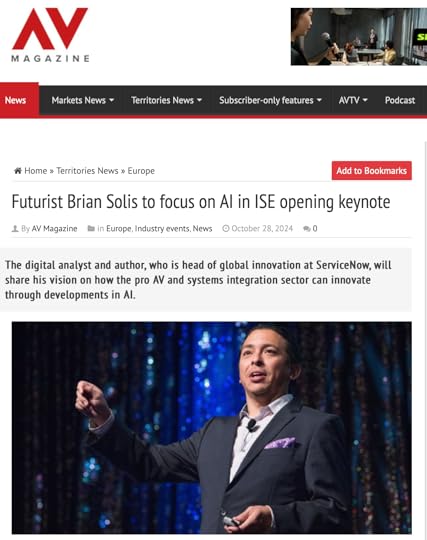
Brian Solis will keynote ISE 2025 in Barcelona. The digital analyst and author, who is head of global innovation at ServiceNow, will share his vision on how the pro AV and systems integration sector can innovate through developments in AI.
The head of global innovation at cloud-based platform ServiceNow will share his vision on how the pro AV and systems integration industry can change and innovate through the latest developments in AI.
Solis is an eight–time best-selling author, known for works such as Mindshift: Transform Transform Leadership, Drive Innovation, and Reshape the Future, X: The Experience When Business Meets Design, and What’s the Future of Business (WTF). His books often explore themes of customer experience, innovation, and the evolving nature of business in a digital world.
In his speech at ISE, Solis will explore the future of tech development driven by AI, and the opportunities and challenges for pro AV and systems integration. The keynote will also address industry pain points such as inertia, business contact loss and outdated systems, providing solutions that restore connections and drive progress.
“I’m beyond excited and also inspired to explore the possibilities AI creates for pro AV and systems integration leaders,” said Solis.
“While there’s a tonne of uncertainty and challenges ahead, I prefer to see the future through an optimistic lens. Together we’ll learn how to find clarity in the unknown and lead the way for everyone to follow.”
Mike Blackman, managing director of Integrated Systems Events, said: “AI is a key topic for the world’s systems integration and AV industry, throwing up enormous opportunities and challenges. Brian’s expertise in the field as a futurist and business leader places him in a unique position to share his insights with our ISE community.”
The post Futurist Brian Solis to Keynote Integrated Systems Europe ISE 2025 in Barcelona appeared first on Brian Solis.
October 27, 2024
Mindshift is a USA Today Bestseller—Thank You!

I can’t even believe I’m writing this.
Mindshift has officially made the USA Today bestseller list! This milestone is beyond anything I could have imagined, and it’s all thanks to your incredible support. After five years since my last book, I felt both excited and uncertain about releasing Mindshift. Quite honestly, in a world that’s changed so much since the release of Lifescale in 2019, I wondered if anyone would remember me or be interested in anything I had to say.
This is more than just a milestone; it’s a celebration of everyone who’s embraced this journey and believed in the power of a new way forward. If there were ever a time, it’s now to start a conversation about change and rally collective courage in a moment that truly needs both.
And wow—your support and enthusiasm is nothing short of inspiring. You’ve shown that there’s a community out there, ready to push past limitations and reach for something better.
The heart of Mindshift is about seeing ourselves and our potential through a new lens, especially in times of rapid change. It’s about challenging norms, envisioning what could be, and taking brave steps forward.
My hope is that these pages serve as a guide and a spark—an invitation to explore the art of the possible, to question, and to be bold. Seeing you all embrace these ideas, to challenge the status quo, and to reshape what’s possible, is why I wrote this book.
So thank you. Thank you for joining me, for sharing Mindshift, and for building a movement that’s bigger than any one of us. This isn’t just a moment; it’s a mindset.
Now, let’s go make a dent in the universe. 

If you haven’t yet had a chance to pick up Mindshift, you can find it on Amazon or wherever you enjoy buying books. I’d love for you to join us as we continue reshaping the future.
With heartfelt gratitude,
Brian Solis
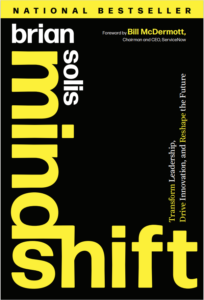
To join my mailing list for news and events, please follow, a Quantum of Solis.
For AInsights, please subscribe here.
The post Mindshift is a USA Today Bestseller—Thank You! appeared first on Brian Solis.

